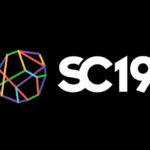High-Speed Products Dazzle at DesignCon 2019
The DesignCon conference never fails to live up to its reputation of being the premier platform for state-of-the-art chip and board technology, and DesignCon 2019 was no different.

Once again, DesignCon demonstrated why it has become the most respected conference and exhibition for engineers engaged in high-performance chip, PCB, and system design. DesignCon 2019 featured an exposition floor with 175 vendors demonstrating the latest advances in high-speed components, channel simulation, and testing capabilities. Emphasis on interconnect technologies has made this conference unique, and this year it attracted 25 leading connector manufacturers and many high-performance cable assembly suppliers, and numerous booths featured live demonstrations of bleeding-edge data rate transmission. Another trademark of this conference is the extensive schedule of technical sessions divided into 15 tracks that addressed the issues engineers face when designing next-generation electronic equipment. Several sessions focused on challenges of 56 and 112Gb/s PAM4 digital circuits.
One of the most significant takeaways from this year’s event is the message that copper interconnects will continue to be alive and well even as the industry pushes beyond 100Gb/s channels. The adoption of PAM4 signaling has enabled copper backplane and I/O connectors to satisfy the signal integrity requirements of the next several generations of equipment. Connectors in both categories continue to be optimized, negating the need for the development of entirely new connector families. Although several new connectors were announced at DesignCon 2019, many live demonstrations utilized existing interfaces.
Representatives of connector companies indicated that most production equipment today utilizes channels that run in the 10 to 15Gb/s range. Component suppliers recognize that interfaces must be capable of supporting next-generation speeds without changing key hardware. Although it may be years before 112Gb/s channels are required, the ability to demonstrate a clear migration path is the motivation to show that the hardware can support these speeds when needed.
The advent of PAM4 is one of the enabling technologies that is essential to designing next-generation equipment. Continuing advances in silicon is another. Years ago, connector manufacturers discovered that fine-tuning of the interface had reached a plateau and that every element in a circuit, including PCB material, layout, and connector launch, as well as twin axial cable construction, have a major impact in overall channel performance. Huge advances in signal conditioning features baked into the silicon have been recognized as providing the “magic” that can distinguish a high-speed signal among the mud of noise. As a result, connector manufacturers have established strategic alliances with select manufacturers of advanced SerDes and ASICs, high-performance PCB material manufacturers, signal integrity specialists, as well as cable suppliers when demonstrating a high-end channel performance. Many connector demonstrations utilized chips from Credo, Inphi, and Xilinx. Successful circuit design now “takes a village” of cooperation.
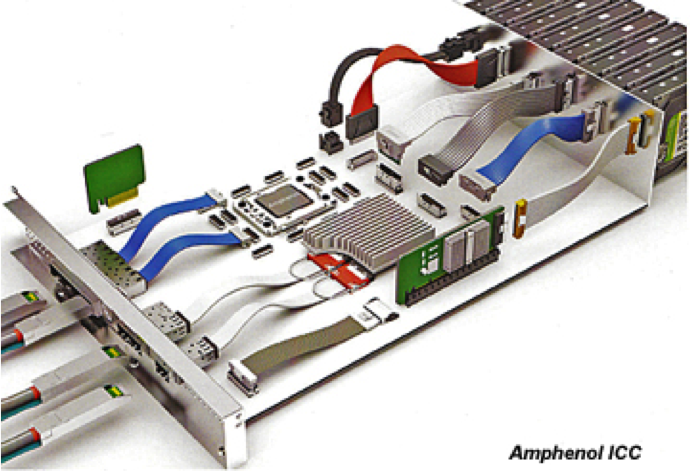 After review of the many high-speed channel demonstrations, it was apparent that loss and distortion associated with even the highest performance PCB materials is driving the trend toward taking high-speed signals out of the PCB and routing them via copper twin axial cable, where impedance, skew, crosstalk, and reflections can be much better controlled. Samtec pioneered this concept several years ago with the introduction of their FireFly Micro Flyover family of copper and fiber interconnects. This concept is now being adopted by many others. Low-profile, high-density, separable cable-to-PCB connectors are proliferating with far-end termination to another location on the PCB, a QSFP I/O, or backplane connector.
After review of the many high-speed channel demonstrations, it was apparent that loss and distortion associated with even the highest performance PCB materials is driving the trend toward taking high-speed signals out of the PCB and routing them via copper twin axial cable, where impedance, skew, crosstalk, and reflections can be much better controlled. Samtec pioneered this concept several years ago with the introduction of their FireFly Micro Flyover family of copper and fiber interconnects. This concept is now being adopted by many others. Low-profile, high-density, separable cable-to-PCB connectors are proliferating with far-end termination to another location on the PCB, a QSFP I/O, or backplane connector.
Another trend at the show was the continuing effort on the part of connector manufacturers to expand the menu of resources and product offerings through acquisition. Internal development of a new category of product or service can be expensive and time-consuming. Acquisition of an existing supplier provides immediate entry and recognition as a significant player. This trend has been apparent over the past few years as several connector manufacturers have greatly expanded their involvement in connector-related electronic sensors. Suppliers are moving into synergistic technologies, including semiconductors and software. Molex recently acquired Nallatech and BittWare to offer FPGA accelerator products for computer, network, and storage applications. Samtec added nMode to their electronic packaging group to advance their 2D, 2.5D, and 3D device packaging capabilities. TE Connectivity made a major commitment to expanding its involvement in the electronic sensor industry with its acquisition of Measurement Specialties. Amphenol recently purchased Ardent Concepts to gain access to their portfolio of compression contacts.
The booths of major connector manufacturers featured an extensive array of high-performance interconnects and live demonstrations.
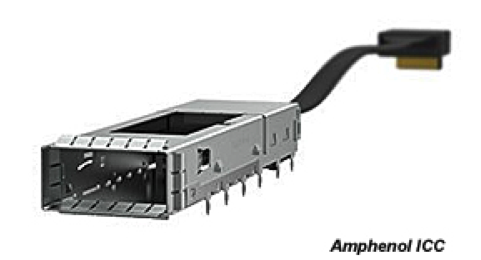 Amphenol ICC showcased their growing line of internal OverPass cable products, including PCB to SFP, QSFP, and QSFP-DD I/O connectors.
Amphenol ICC showcased their growing line of internal OverPass cable products, including PCB to SFP, QSFP, and QSFP-DD I/O connectors.
The new LinkOVER compression cable connector running 112Gb/s PAM4 over one meter of cable is the most recent addition to the OverPass stable of interconnects.
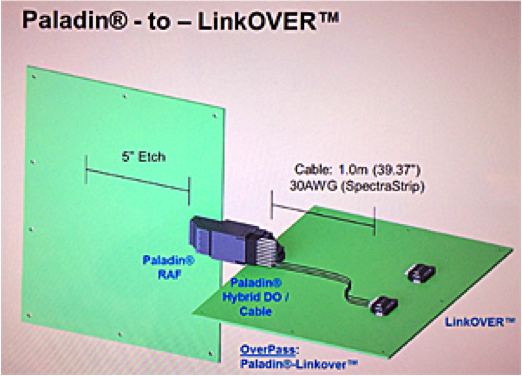 Pure cable backplanes remain a niche application and are practical in relatively few high-end applications, while orthogonal midplane and orthogonal direct configurations are continuing to gain acceptance. Amphenol ICC suggests a hybrid configuration of their Paladin orthogonal backplane connector that integrates both right-angle PCB contacts as well as provision for accepting differential shielded cables that handle the highest speed signals.
Pure cable backplanes remain a niche application and are practical in relatively few high-end applications, while orthogonal midplane and orthogonal direct configurations are continuing to gain acceptance. Amphenol ICC suggests a hybrid configuration of their Paladin orthogonal backplane connector that integrates both right-angle PCB contacts as well as provision for accepting differential shielded cables that handle the highest speed signals.
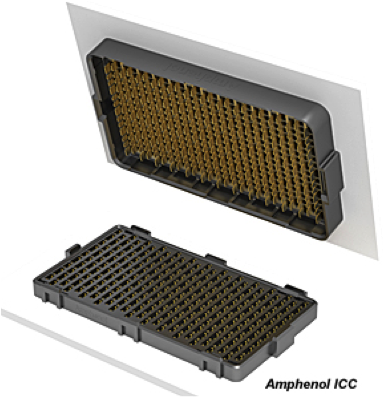 Continuing to expand their line of low-profile mezzanine connectors, Amphenol demonstrated the new M-Series 56 connector operating at 56Gb/s NRZ. This versatile connector offers a range of stacking heights from 4 to 15mm.
Continuing to expand their line of low-profile mezzanine connectors, Amphenol demonstrated the new M-Series 56 connector operating at 56Gb/s NRZ. This versatile connector offers a range of stacking heights from 4 to 15mm.
Molex featured a wide variety of high-speed interfaces, including the new MirrorMezz stacking connector. This hermaphroditic mezzanine connector features stack heights of 2.5 to 11mm.
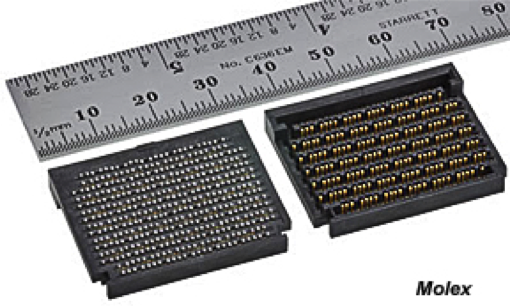
Contacts can be loaded to provide custom configurations to support single-ended and differential signaling as well as power distribution.
An extension of the MirrorMezz connector has been adapted for termination to differential cable. Designated the Twin-AX Grid Array (TGA), this low-profile, high-density assembly can deliver 112Gb/s PAM4 channels. Molex sees this type of “waveguide interconnect” as a possible path to 224Gb/s channels.
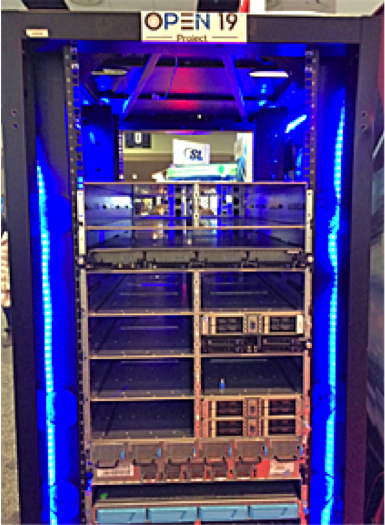 Additional demonstrations included QSFP-DD direct attached cable assemblies operating at 56Gb/s PAM4 and an Impulse orthogonal direct cable backplane connector running at 112Gb/s PAM4. Molex also featured their QSFP-DD cable assemblies delivering 400Gb/s Ethernet over three-meter cable assemblies.
Additional demonstrations included QSFP-DD direct attached cable assemblies operating at 56Gb/s PAM4 and an Impulse orthogonal direct cable backplane connector running at 112Gb/s PAM4. Molex also featured their QSFP-DD cable assemblies delivering 400Gb/s Ethernet over three-meter cable assemblies.
The Molex booth included a full Open 19 rack showing the many variations of interconnect available.
Concern about thermal issues continues to dog the industry, as higher speeds often result in increased power demand that generates more waste heat. Increases in system packaging density makes thermal management even more difficult. A Molex demonstration server illustrated the difference in thermal efficiency based on the orientation of a QSFP-DD connector.
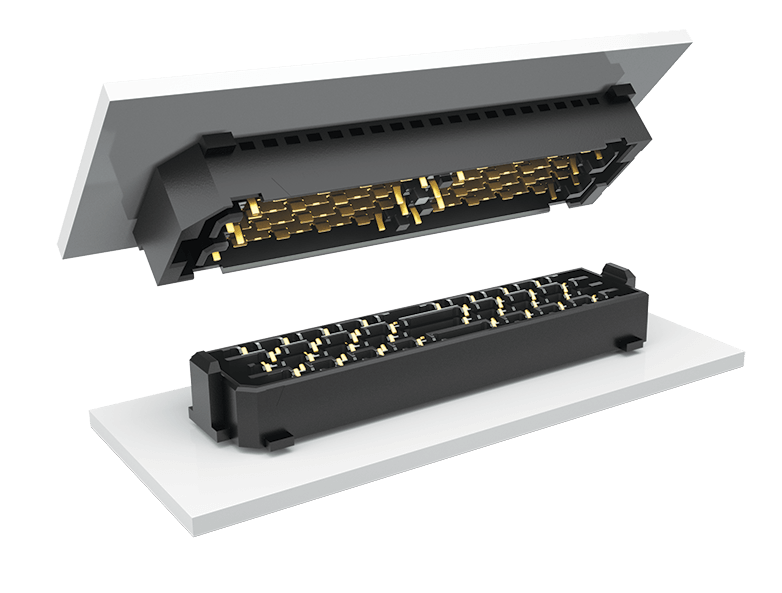
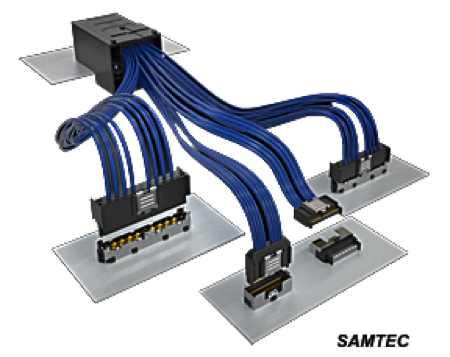 Samtec continues to expand its impressive line of high-performance board-to-board and board-to-cable connectors. The NovaRay is an extreme high-density stacking connector rated to 56Gb/s NRZ, allowing a single connector to conduct 9 IEEE 400Gb/s channels. This interface has been adapted to an internal cable configuration and was demonstrated in a one-meter Flyover application of QSFP28 to a vertical NovaRay running 112Gb/s PAM4.
Samtec continues to expand its impressive line of high-performance board-to-board and board-to-cable connectors. The NovaRay is an extreme high-density stacking connector rated to 56Gb/s NRZ, allowing a single connector to conduct 9 IEEE 400Gb/s channels. This interface has been adapted to an internal cable configuration and was demonstrated in a one-meter Flyover application of QSFP28 to a vertical NovaRay running 112Gb/s PAM4.
Another demonstration included a five-meter ExaMAX cable backplane assembly running at 56Gb/s PAM4.
Samtec also featured an open chassis active product demonstrator featuring 56Gb/s NRZ running over a variety of connectors, including AcceleRate, ExaMAX backplane, QSFP28 I/O, and flyover cables.
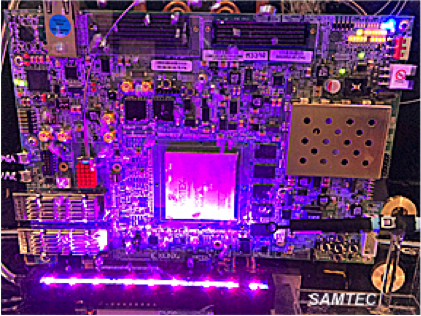 In order to address thermal issues, especially in supercomputer and future quantum computing applications, Samtec demonstrated a 28Gb/s NRZ FireFly connector adapted for submersion in 3M Fluorinert liquid.
In order to address thermal issues, especially in supercomputer and future quantum computing applications, Samtec demonstrated a 28Gb/s NRZ FireFly connector adapted for submersion in 3M Fluorinert liquid.
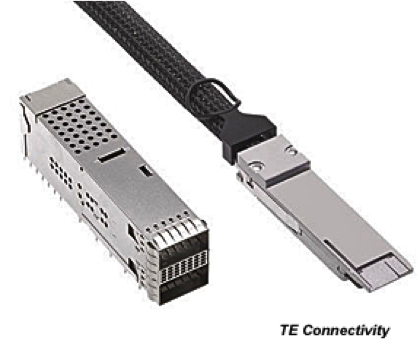 The TE Connectivity booth featured multiple live demonstrations, including OSFP 112Gb/s PAM4 over two meters of direct attach copper cable for an aggregate of 896Gb/s per connector.
The TE Connectivity booth featured multiple live demonstrations, including OSFP 112Gb/s PAM4 over two meters of direct attach copper cable for an aggregate of 896Gb/s per connector.
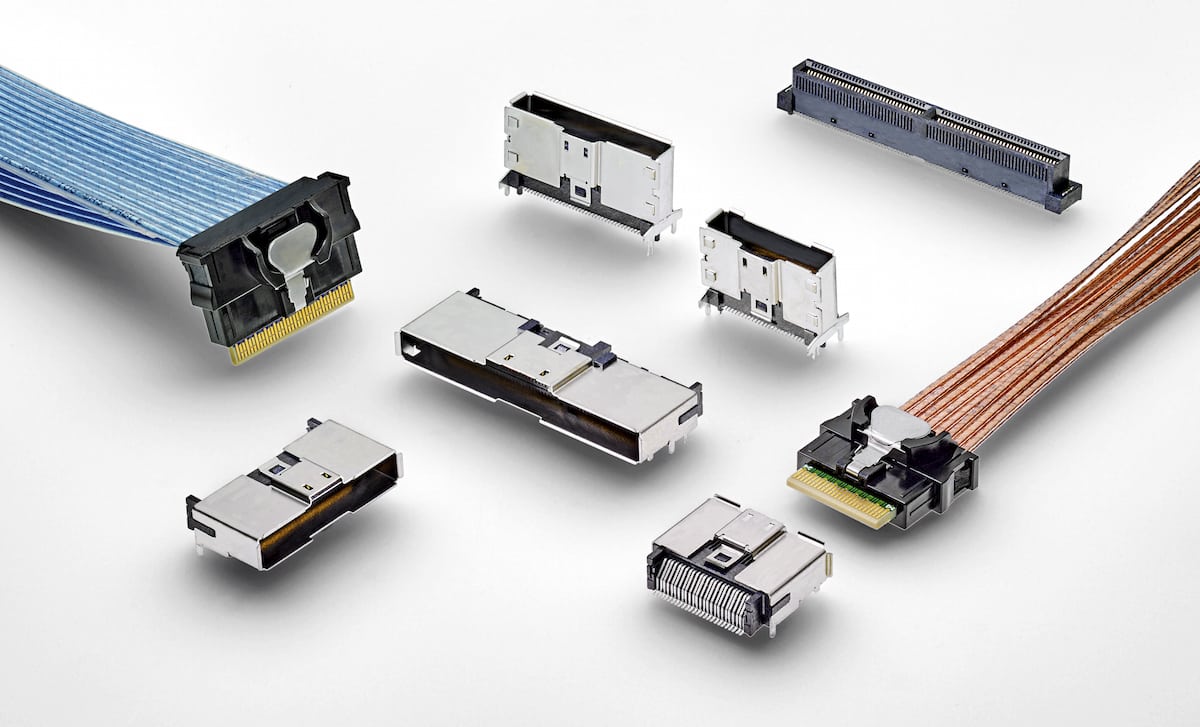 The Sliver connector continues to be defined in an expanding list of specifications, including Gen-Z, EDSFF, COBO, and Open Compute. Configurations now include vertical, right-angle, straddle mount, and orthogonal.
The Sliver connector continues to be defined in an expanding list of specifications, including Gen-Z, EDSFF, COBO, and Open Compute. Configurations now include vertical, right-angle, straddle mount, and orthogonal.
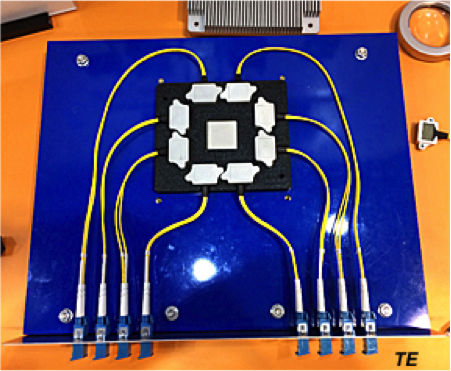 The TE booth also featured several developmental concepts to address next-generation challenges. One board displayed a large LGA socket consisting of a series of mid-board optical transceivers that would convert electrical signals from the processor to optic links that lead to the faceplate.
The TE booth also featured several developmental concepts to address next-generation challenges. One board displayed a large LGA socket consisting of a series of mid-board optical transceivers that would convert electrical signals from the processor to optic links that lead to the faceplate.
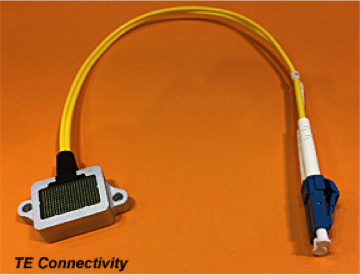 Another LGA socket would be capable of supporting a device with up to 10,000 contact points.
Another LGA socket would be capable of supporting a device with up to 10,000 contact points.
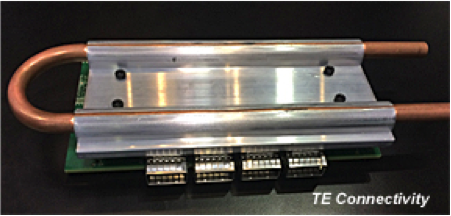 Recognizing the challenge in controlling temperatures in the box, TE demonstrated an enhanced QSFP-DD heat sink that enables safe operation to 15 watts. They also showed a module of four QSFP connectors with an integrated liquid cooled heat sink.
Recognizing the challenge in controlling temperatures in the box, TE demonstrated an enhanced QSFP-DD heat sink that enables safe operation to 15 watts. They also showed a module of four QSFP connectors with an integrated liquid cooled heat sink.
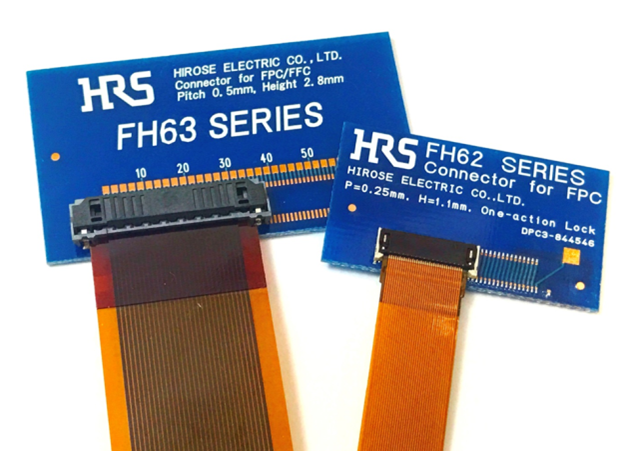 Hirose showcased its expanding portfolio of high-speed mezzanine connectors, including the IT3, 5, 8, 9, and 11 series as well as the FH series of low-profile flex film connectors. They also showed their SMP miniature coax connectors rated to 40Ghz.
Hirose showcased its expanding portfolio of high-speed mezzanine connectors, including the IT3, 5, 8, 9, and 11 series as well as the FH series of low-profile flex film connectors. They also showed their SMP miniature coax connectors rated to 40Ghz.
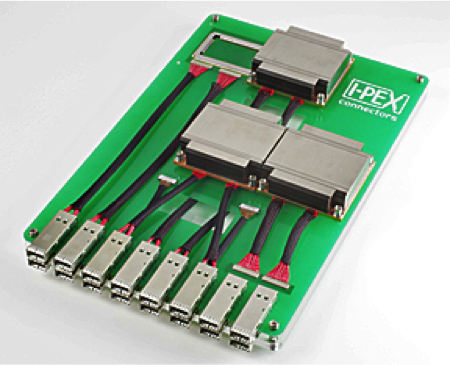 The ability to bring copper cable links as close as possible to the footprint of a SerDes or ASIC is a developing trend. I-PEX specializes in extremely dense, high-speed, cable-to-board connectors that feature a profile low enough to fit under a large heat sink, reducing the signal path through lossy PCB material.
The ability to bring copper cable links as close as possible to the footprint of a SerDes or ASIC is a developing trend. I-PEX specializes in extremely dense, high-speed, cable-to-board connectors that feature a profile low enough to fit under a large heat sink, reducing the signal path through lossy PCB material.
The race to develop even more pluggable I/O connectors appears to be settling down. A host of cable assembly manufacturers promoted the full array of SFP through OSFP configurations. The Luxshare ICT booth, for instance, featured QSFP56 and QSFP-DD Direct Attached Active Optical Cables, SFP-DD copper cables, and low-profile SLIMSAS cables and PCB connectors for PCIe Gen 3,4, and 5 applications. Each of these interfaces are finding high-volume, long-term applications.
Several companies introduced new interfaces in anticipation of 5G networks springing up everywhere, including antennas, subminiature coaxial connectors, as well as components used in central office, cloud, and data center infrastructure. The challenge will be adapting what has been high-end interfaces to the cost constraints of high-volume commercial applications. This new market potential is seen as a growth driver for the connector industry for at least the next five years. Samtec has already produced a solution guide for 5G applications, while TE has an excellent 5G white paper, “Mass Connectivity in the 5G Era.”
One of the most interesting observations that came out of DesignCon 2019 was a change in expectation for when fiber optic links may become required. In a major shift from last year, when most connector representatives indicated that 112Gb/s PAM4 was the practical limit of copper channels, the opinion this year leaned more to the possibility of achieving 224Gb/s channels. Few would conjecture on how that will be achieved but perhaps a combination of advanced silicon, new interconnect structures, and PAM8 signaling may provide a path.
Like this article? Check out our other DesignCon, high-speed, Datacom/Telecom, and New Technology articles.
- Optics Outpace Copper at OFC 2024 - April 16, 2024
- Digital Lighting Enhances your Theatrical Experience - March 5, 2024
- DesignCon 2024 in Review - February 13, 2024


